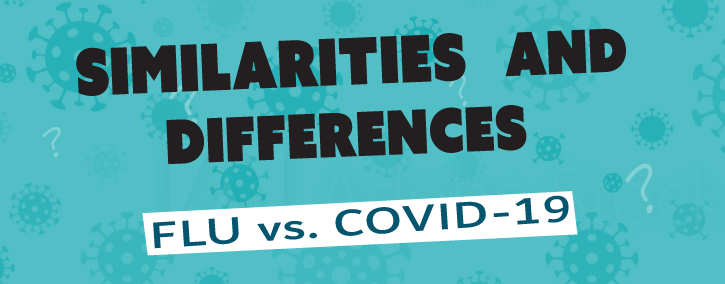Information Published by: Centers for Disease Control and Prevention
Flu vs. COVID-19
Influenza (Flu) and COVID-19 are both contagious respiratory illnesses, but they are caused by different viruses. COVID-19 is caused by infection with a new coronavirus (called SARS-CoV-2) and flu is caused by infection with influenza viruses. Because some of the symptoms of flu and COVID-19 are similar, it may be hard to tell the difference between them based on symptoms alone, and testing may be needed to help confirm a diagnosis. Flu and COVID-19 share many characteristics, but there are some key differences between the two.
While more is learned every day, there is still a lot that is unknown about COVID-19 and the virus that causes it. This table compares COVID-19 and flu, given the best available information to date.
Signs and Symptoms
Similarities:
Both COVID-19 and flu can have varying degrees of signs and symptoms, ranging from no symptoms (asymptomatic) to severe symptoms. Common symptoms that COVID-19 and flu share include:
- Fever or feeling feverish/chills
- Cough
- Shortness of breath or difficulty breathing
- Fatigue (tiredness)
- Sore throat
- Runny or stuffy nose
- Muscle pain or body aches
- Headache
- Some people may have vomiting and diarrhea, though this is more common in children than adults
Differences:
Flu:
Flu viruses can cause mild to severe illness, including the common signs and symptoms listed above.
COVID-19:
COVID-19 seems to cause more serious illnesses in some people. Other signs and symptoms of COVID-19, different from flu, may include change in or loss of taste or smell.
How Long Symptoms Appear After Exposure and Infection
Similarities:
For both COVID-19 and flu, 1 or more days can pass between a person becoming infected and when he or she starts to experience illness symptoms.
Differences:
If a person has COVID-19, it could take them longer to develop symptoms than if they had flu.
Flu:
Typically, a person develops symptoms anywhere from 1 to 4 days after infection.
COVID-19:
Typically, a person develops symptoms 5 days after being infected, but symptoms can appear as early as 2 days after infection or as late as 14 days after infection, and the time range can vary.
How Long Someone Can Spread the Virus
Similarities:
For both COVID-19 and flu, it’s possible to spread the virus for at least 1 day before experiencing any symptoms.
Differences:
If a person has COVID-19, they may be contagious for a longer period of time than if they had flu.
Flu:
Most people with flu are contagious for about 1 day before they show symptoms.
- Older children and adults with flu appear to be most contagious during the initial 3-4 days of their illness but many remain contagious for about 7 days.
- Infants and people with weakened immune systems can be contagious for even longer.
COVID-19:
How long someone can spread the virus that causes COVID-19 is still under investigation.
- It’s possible for people to spread the virus for about 2 days before experiencing signs or symptoms and remain contagious for at least 10 days after signs or symptoms first appeared. If someone is asymptomatic or their symptoms go away, it’s possible to remain contagious for at least 10 days after testing positive for COVID-19.
How it Spreads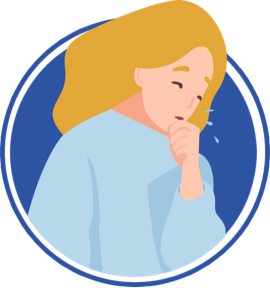
Similarities:
Both COVID-19 and flu can spread from person-to-person, between people who are in close contact with one another (within about 6 feet). Both are spread mainly by droplets made when people with the illness (COVID-19 or flu) cough, sneeze or talk. These droplets can land in the mouths or noses of people who are nearby or possibly be inhaled into the lungs.
- It may be possible that a person can get infected by physical human contact (e.g. shaking hands) or by touching a surface or object that has a virus on it and then touching his or her own mouth, nose, or possibly their eyes.
- Both the flu virus and the virus that causes COVID-19 may be spread to others by people before they begin showing symptoms, with very mild symptoms or who never developed symptoms (asymptomatic).
Differences:
While COVID-19 and flu viruses are thought to spread in similar ways, COVID-19 is more contagious among certain populations and age groups than flu. Also, COVID-19 has been observed to have more superspreading events than flu. This means the virus that causes COVID-19 can quickly and easily spread to a lot of people and result in continuous spreading among people as time progresses.
How Flu Spreads
How COVID-19 Spreads
People at High-Risk for Severe Illness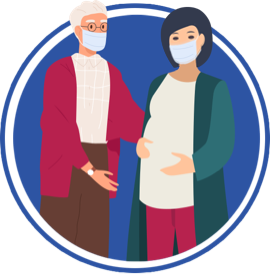
Similarities:
Both COVID-19 and flu illness can result in severe illness and complications. Those at highest risk include:
- Older adults
- People with certain underlying medical conditions
- Pregnant people
Differences:
The risk of complications for healthy children is higher for flu compared to COVID-19. However, infants and children with underlying medical conditions are at increased risk for both flu and COVID-19.
Flu:
Young children are at higher risk of severe illness from flu.
People at High Risk for Flu Complications
COVID-19:
School-aged children infected with COVID-19 are at higher risk of Multisystem Inflammatory Syndrome in Children (MIS-C), a rare but severe complication of COVID-19.
People at Increased Risk of COVID-19 Severe Illness
Complications
Similarities:
Both COVID-19 and flu can result in complications, including:
- Pneumonia
- Respiratory failure
- Acute respiratory distress syndrome (i.e. fluid in lungs)
- Sepsis
- Cardiac injury (e.g. heart attacks and stroke)
- Multiple-organ failure (respiratory failure, kidney failure, shock)
- Worsening of chronic medical conditions (involving the lungs, heart, nervous system or diabetes)
- Inflammation of the heart, brain or muscle tissues
- Secondary bacterial infections (i.e. infections that occur in people who have already been infected with flu or COVID-19)
Differences:
Flu:
Most people who get flu will recover in a few days to less than two weeks, but some people will develop complications, some of these complications are listed.
COVID-19:
Additional complications associated with COVID-19 can include:
- Blood clots in the veins and arteries of the lungs, heart, legs or brain
- Multisystem Inflammatory Syndrome in Children (MIS-C)
COVID-19 Emergency warning signs
Approved Treatments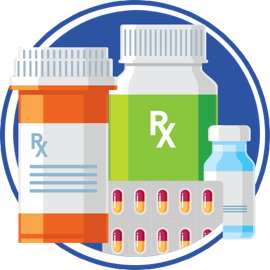
Similarities:
People at high-risk of complications or who have been hospitalized for COVID-19 or flu should receive supportive medical care to help relieve symptoms and complications.
Differences:
Flu:
Prescription influenza antiviral drugs are FDA-approved to treat flu.
- People who are hospitalized with flu or at high-risk of flu complications with flu symptoms are recommended to be treated with antiviral drugs as soon as possible.
COVID-19
The National Institutes of Health (NIH) has developed guidance on the treatment of COVID-19, which will be regularly updated as new evidence on treatment options emerges.
- While remdesivir is an antiviral agent that is being explored as a treatment for COVID-19 and is available under an Emergency Use Authorization (EUA), there are currently no drugs or other therapeutics approved by the Food and Drug Administration (FDA) to prevent or treat COVID-19. Studies are in progress to learn more.
What to Do If You Are Sick with COVID-19
Vaccine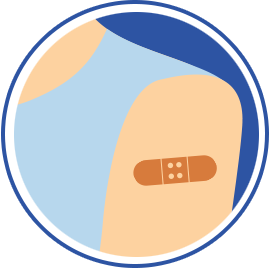
Similarities:
Vaccines for COVID-19 and flu must be approved or authorized for emergency use (EUA) by the FDA.
Differences:
Flu:
There are multiple FDA-licensed influenza vaccines produced annually to protect against the 3 or 4 flu viruses that scientists anticipate will circulate each year.
COVID-19:
Currently, there is no vaccine to prevent COVID-19. Vaccine developers and other researchers and manufacturers are expediting the development of a vaccine to prevent COVID-19.
Read More @ https://www.cdc.gov/flu/symptoms/flu-vs-covid19.htm
Learn About Infection Prevention @ https://www.wickhosp.com/blog/infection-prevention/

